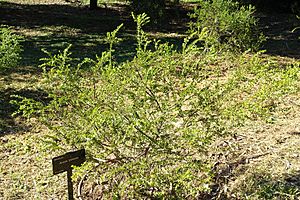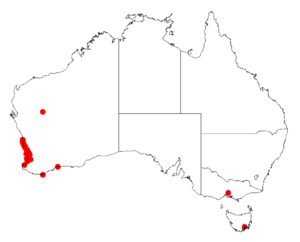Angle leaved wattle facts for kids
Quick facts for kids Angle leaved wattle |
|
|---|---|
 |
|
| Scientific classification | |
| Genus: |
Acacia
|
| Species: |
truncata
|
 |
|
| Occurrence data from AVH | |
Acacia truncata, often called the angle leaved wattle or west coast wattle, is a type of shrub that grows near the coast. It belongs to the plant family called Fabaceae, which includes peas and beans. You can find this plant naturally along the southwest coast of Western Australia. It was one of the first Australian plants ever collected by European scientists.
Contents
What Does it Look Like?
This wattle is a thick, dome-shaped shrub. It usually grows between 0.5 and 2.3 meters (about 1.5 to 7.5 feet) tall. Its branches are ribbed and smooth, meaning they don't have hairs.
Flowers and Seeds
The flowers are pale yellow and shaped like small globes. Each flowerhead has about 7 to 16 flowers. They grow on stalks that are 10 to 25 millimeters long. After the flowers bloom, the plant forms blackish seed pods. These pods are curved or straight, about 6.5 centimeters (2.5 inches) long, and 2 to 4 millimeters wide. They have thick yellowish edges. Inside, the seeds are shiny brown and arranged lengthwise. They are oblong or oval-shaped and about 3 to 3.5 millimeters long.
Phyllodes (Not True Leaves!)
Like many other Acacia species, A. truncata has special structures called phyllodes instead of true leaves. These phyllodes are triangular. They are usually 9 to 25 millimeters long and 5 to 13 millimeters wide.
How it Got its Name
This plant has had a few different names over time.
Early Discoveries
The species was first described in 1768 by a scientist named Nicolaas Laurens Burman. He called it Adiantum truncatum. Later, in 1824, another botanist named Johann Centurius Hoffmannsegg formally gave it the name Acacia truncata.
Name Changes
Sometimes, plants get renamed or reclassified. For a while, Acacia decipiens was considered another name for this plant. In 2003, it was briefly moved to a different group called Racosperma truncatum. But in 2016, scientists decided it belonged back in the Acacia group.
Meaning of the Name
The name truncata comes from a Latin word. It means 'to cut off'. This refers to the short, blunt (cut-off) tip of the plant's phyllodes. Acacia truncata is also very similar to another wattle called Acacia littorea.
Where Does it Grow?
Acacia truncata is found along the west coast of Western Australia. Its range stretches from the Mid West region down through the Wheatbelt and Peel areas, all the way to the South West. You can find it as far north as Carnamah and as far south as Harvey.
It likes to grow in sandy soils and thin, rocky soils. You'll often see it among sand dunes and on patches of coastal limestone. It's a common plant in these coastal heath communities.
Growing and Using This Wattle
You can buy Acacia truncata as seedlings or seeds. It's quite easy to grow from seeds.
Planting Tips
The best time to collect seeds is in December or January. Before planting, the seeds need a special treatment. You can soak them in hot water or gently scratch their outer layer. This helps them sprout. They grow best in a soil mix that drains water well.
Good for Coastal Gardens
This wattle is often used for restoring natural areas, especially along the coast. It's planted with other low shrubs like Olearia axillaris and Lomandra maritima. A. truncata needs some protection from very strong winds. It can handle frost and even salt water spray. This makes it a great choice for gardens near the ocean.
Images for kids



